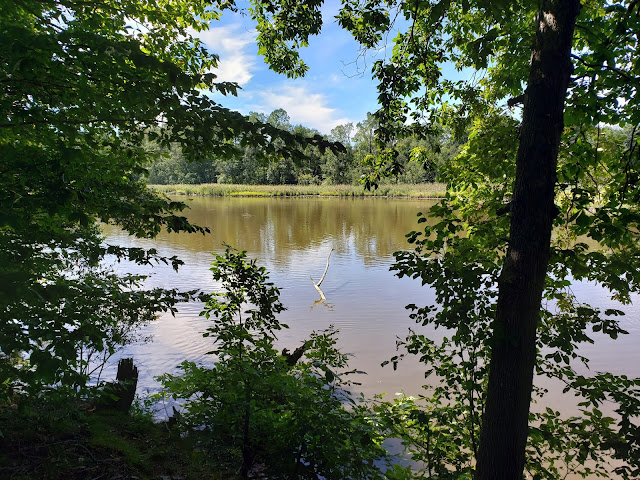Blackbird Creek Reserve: A Pleasant Walk and Interesting Historic Sites Nearby
 |
| Blackbird Creek |
A couple of miles south of Odessa is Blackbird Creek Reserve. We spent a pleasant morning over Labor Day weekend visiting it and seeing some nearby historic buildings.
Blackbird Creek Reserve has three short, easy trails. You can download a map of the trails, but at the park they’re also clearly marked with color-coded markers.
 |
| Trail signpost at Blackbird Creek Reserve |
We took the 2-kilometer yellow trail, which looped through woods and open areas and gave us glimpses of Blackbird Creek. The trails are mowed grass, which makes for a pleasant, comfortable walk.
 |
| Part of the Blackbird Creek Reserve yellow trail |
Some of the trees are labeled.
There’s birdwatching station near Blackbird Creek.
 |
| Birdwatching station at Blackbird Creek Reserve |
We paused here…and saw a bird fly in and land in the creek! It was too far away for us to tell what kind of bird it was.
 |
| Is it a crane? egret? heron? |
An open area has been transformed into a nursery for native
plants.
 |
| Native plant nursery at Blackbird Creek Reserve |
Blackbird Creek Reserve has a parking lot, picnic pavilion, and a couple of portapotties. Visit its web page for more information on the Reserve.
Old Union Church is about a mile west of Blackbird Creek Reserve, on US 13 just south of Willey Farms at Union Church Road.
 |
| Old Union Methodist Episcopal Church |
It was built in 1847 to replace a Methodist chapel made of logs. It was active through the early 1900s. Since 1939 the Old Union Church Society maintains it and opens it for special occasions.
 |
| Old Union Church doorway, with name and date above and below |
It’s surrounded by a large cemetery that would be fun to explore.
 |
| Part of Old Union Church cemetery |
About a mile west of Blackbird Creek Reserve, on DE 9
(Taylors Bridge Road) is Huguenot House, also know as Elias Naudain House.
 |
| Huguenot House or Elias Naudain House |
Like many older houses along the Delaware Bayshore Byway, Huguenot House was built in sections. The left side of the house was probably built around 1735 and the right side a few decades later. The Society of Architectural Historians’ Archipedia has a good article on Huguenot House.
 |
| Huguenot House or Elias Naudain House |
Continue about a
mile further down DE 9, over Taylor’s Bridge, and you’ll soon see Reedy Island
Rear Range Lighthouse on your left.
 |
| Reedy Island Rear Range Lighthouse |
As noted in my post on the Liston Range Lighthouses, the Delaware River isn’t deep enough for modern ships, so a channel has been dug down the middle. Range lighthouses were pairs of lighthouses designed to help ships stay in the channel in the days before satellites and GPS. When the two lighthouse lights aligned, one on top of the other, the ship was in the proper position in the channel.
The Reedy Island Rear Range Lighthouse was built in 1910 of cast iron. The Liston Rear Range Lighthouse may look similar, but it was built 35 years earlier of wrought iron. LighthouseFriends.com has a great article on the Reedy Island Rear Range Lighthouse. The article also discusses the Reedy Island Front Range Lighthouse, which no longer exists.
UPDATE 6/10/2021: Someone on Facebook shared these historic photos of the Reedy Island Rear Range Lighthouse. This photo shows the lightkeeper's house, which burned down in 2002.
 |
| Undated photo of Reedy Island Rear Range Lighthosue |
This photo shows the lighthouse keeper.
 |
| Undated photo of Reedy Island Rear Range Lighthouse keeper |
Just past the lighthouse on DE 9 is the adorable Taylor’s Bridge School, built in 1923 to replace a nearby frame schoolhouse destroyed in a storm. A delightful example of Colonial Revival architectural style popular in the early 20th century, it’s now used as a community center.
 |
| Taylor's Bridge School |




Comments
Post a Comment